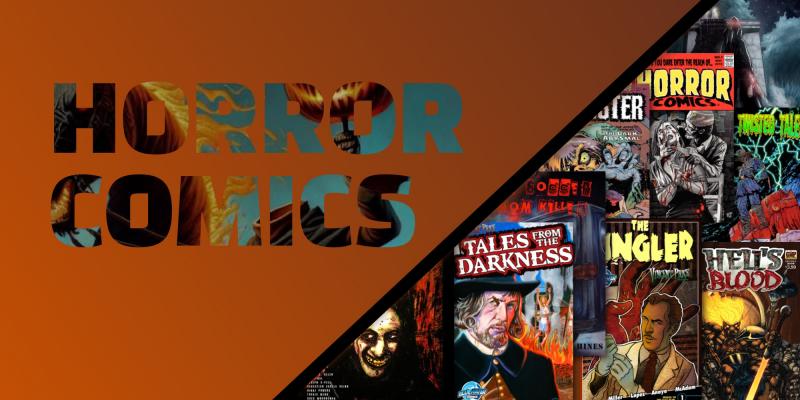by Lindsey Winsemius - Posted 1 month ago

Horror comics have long been a shadowy cornerstone of the medium, blending visceral artwork with spine-tingling narratives to evoke fear, unease, and the uncanny. From the lurid pages of mid-20th-century anthologies to today's indie digital marketplaces, the genre has morphed from pulp sensationalism to sophisticated explorations of the human psyche. Platforms like CryptoComics.com exemplify this evolution, offering horror from the Golden Age through contemporary indie horror comics.
Let's explore the story of horror comics over time.
At its core, horror in comics thrives on visual immediacy—grotesque illustrations that hit harder than words alone. Several tropes recur across eras, amplified by the sequential art form's ability to build tension panel by panel.
These tropes aren't static; they've adapted to cultural shifts, from Cold War paranoia to contemporary existential dread.
Horror comics' journey reflects broader comic industry upheavals, from censorship battles to digital democratization.
Post-WWII America craved escapism laced with taboo thrills. Enter EC Comics' Tales from the Crypt and Vault of Horror (1950–1955), which popularized anthology horror with twisty morals, severed heads, and social commentary on racism and war. Artists like Jack Davis and Graham Ingels mastered grotesque caricature, but the Comics Code Authority (1954) nearly killed the genre by banning "excessive" violence and horror. Survival came via diluted reprints and underground presses.
The counterculture birthed raw, psychedelic horror in underground comix like Robert Crumb's Zap Comix (1968 onward), where body horror met sexual taboos. By the 1970s, Marvel's Tomb of Dracula (1972–1979) and DC's House of Mystery revived serialized scares. The 1980s saw a boom with Warren Publishing's Eerie and Creepy magazines, pushing mature themes amid Reagan-era conservatism. Tropes evolved too: monsters gained depth, like sympathetic vampires exploring immortality's loneliness.
DC's Vertigo imprint revolutionized horror with adult-oriented prestige titles. Neil Gaiman's The Sandman (1989–1996) wove mythological dread into literary tapestries, while Hellblazer (1988–2013) grounded supernatural horror in gritty urban realism. Tropes shifted toward psychological depth—demons as inner demons—and diverse voices, including feminist takes on witches in The Invisibles. Independents like Hellboy (1993–present) by Mike Mignola and Beowulf by Antarctic Press blended folklore with noir, proving horror could be arthouse.
The 2010s brought accessibility via webcomics and apps, with Image Comics' Something is Killing the Children (2019–ongoing) subverting monster hunts through a queer, teen protagonist. Tropes now interrogate identity, colonialism, and climate anxiety—zombies as metaphors for overconsumption, ghosts as unresolved historical trauma.
Platforms like CryptoComics democratize distribution, letting indie creators sell NFTs of their work, fostering serialized sagas for niche audiences. This era emphasizes inclusivity, with horror for preteens toning down gore for atmospheric chills, while mature titles dive into explicit viscera.
CryptoComics.com's marketplace captures this spectrum, blending nostalgic echoes with fresh frights. Its titles include both family-friendly chills and edgier fare, highlighting how tropes endure in bite-sized digital formats.
The Vincent Price Presents series revives EC-style anthologies. Hosted by the iconic horror host's digitized likeness, these graphic novels deliver twisty tales of haunted heirlooms and vengeful spirits—moral fables with supernatural intrusions, perfect for young readers building tolerance for terror. Similarly, Monster #1–#2 and Tinglers #1–#2 lean into monstrous others with creature features, evoking 1950s matinee vibes.

Baffling Mysteries adds detective-horror hybrids, where psychological puzzles unravel into uncanny revelations. The longest preteen entry, Last Day #GN, suggests an apocalyptic graphic novel trope—humanity's final hours fraught with body horror and existential dread.

Young adults get serialized urban fantasy-horror in the Styx & Stone series, a modern nod to 1980s Vertigo grit. These issues likely explore cursed artifacts and demonic pacts in contemporary settings, evolving the supernatural intrusion trope with character-driven arcs—think reluctant heroes navigating hellish underworlds. Hell's Blood #1: Scent of Blossoms hints at gothic romance laced with vampiric seduction, updating classic monstrous lovers for YA introspection.

Mature readers dive deeper into twisted psyches with Creepsi Twisted Tales, channeling underground comix' body horror and moral ambiguity—perhaps dismembered narratives with ironic twists. The Darkest Shade: Book 1 promises psychological torment in a shadowy saga, akin to 1990s prestige horror's literary bent.
These examples underscore trends: serialized accessibility for younger fans, echoing EC's anthologies; indie depth for adults, mirroring Vertigo's legacy. CryptoComics' digital model—tradable comics as NFTs—further evolves the genre, turning passive reading into communal, resale-fueled storytelling.
Horror comics persist because they mirror our fears while offering catharsis, their tropes timeless yet ever-adapting. From EC's censored shocks to CryptoComics' indie influx, the genre has clawed its way from margins to mainstream, proving that in panels of ink and shadow, the scariest stories are the ones that linger.
Whether you're a preteen dipping into Tinglers or a veteran savoring Creepsi's depravity, today's horror invites us all to confront the darkness—and maybe resell the nightmare afterward. Dive into CryptoComics' marketplace to unearth your next haunt.